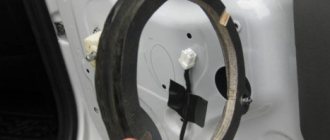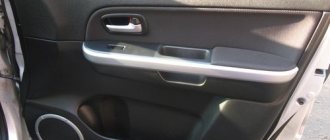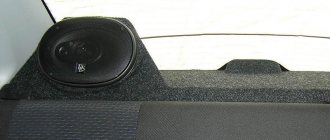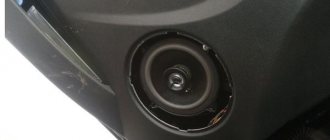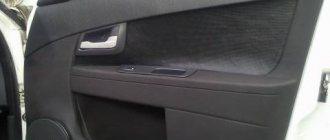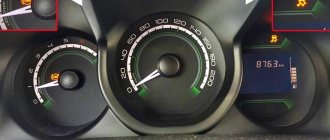The standard audio equipment of a Lada Granta liftback car includes: a 2-DIMM radio, two speakers in the front door measuring 13 cm, blocks with wires in the rear door.
Obviously, such an audio system is not complete and of low quality. The stock speakers are too small, weak when using mid and high frequencies. It's enough to listen to the radio. Is it worth changing the standard speakers? The answer is yes.
Acoustics for the front doors of Lada Granta
Installing speakers in Granta doors allows you to be independent of the body type - speakers in the doors do not require an acoustic shelf. This means that you can install speakers in a sedan and a hatchback according to the same principle.
Preparatory work
Before we begin the installation itself, let's figure out how to prepare the car. For this:
- We disassemble the door : dismantle the handle (pry up and remove the trim, unscrew 2 screws), the tip of the limit switch, two screws from the bottom of the door, overcoming the resistance of the retaining pins, pull the door card toward you and remove it from the door;
- We soundproof the door: in the warm season or in a heated garage, we cover all accessible parts of the door with vibroplast. Vibroplast StP M2 is suitable; when applying it to the door, be sure to heat it with a construction hairdryer and roll it with a pressure roller;
- If you have Spleen thermal insulation material, we cover the inside of the door card with it. This will further hide noise from the door when assembled;
- We are preparing spacers , if any are required for installing 16 cm speakers - more about them later in the text;
- We replace the factory terminals on the speaker wire in the door with normal ones (usually good terminals are included with the speakers) - to do this, we simply cut off the unnecessary connectors and attach the terminals we need to the wiring. A high-quality twist with heat shrink is enough;
- If the door panels do not have holes for speakers , we prepare them. It would be optimal to supply factory acoustic grids, which are installed on luxury versions of Granta and Datsun OnDo.
Installing speakers in Granta front doors
The standard acoustics in Grant are 13 cm speakers. They do not produce good sound, but they are easily installed in the factory holes for the speakers without unnecessary manipulation. The procedure for dealing with them is simple:
- connect the speaker cables, observing the polarity;
- fix with screws in regular places in the metal of the door or directly on the door card;
- install grids (in common parlance - grills).
An important disadvantage is that the center of the mounting hole and the place under the grill do not coincide. This means that when installed with complete grills, they will look asymmetrical and clumsy.
Standard acoustics most often do not produce a rich sound and, when installed with their own grids, look poor.
How to install 16cm speakers with spacers
In pursuit of sound, it is logical to install 16 cm speakers. This is where all the disadvantages of the AvtoVAZ design appear - the speakers either are not centered, or do not allow the window to roll down, or interfere with the glove compartment lid.
Why are spacers needed ? In order not to cut the door, if you do not put the acoustics in the spacer rings, you will have to attach it to the metal of the door. This may result in the need to cut the door itself in order for the speaker to fit in, and is dangerous for the glass.
For this reason, speaker rings made of plywood are attached to the metal of the door, and the speaker itself is attached to them.
The procedure is as follows:
- we make or buy spacers for speakers - thickness 10 mm, material plywood;
- cut a hole for the speaker in the card and mark the installation location along it;
- put the spacer on 4 self-tapping screws;
- We install a column in it - observe the polarity!;
- install the map + install the standard mesh so that it doesn’t interfere with the glove compartment.
If the spacer bursts during installation, this may result in a rattling noise coming from the door while driving.
What speakers are better to put in the front doors instead of standard speakers?
We recommend the Pioneer TS-G1733I model. At a price of about 2 thousand rubles, they are freely installed through spacers in Granta doors without cutting metal and do not interfere with the glass. Easy installation will save you nerves and time.
The speakers are easily pumped with a radio without an amplifier and produce medium bass. Not component acoustics!
Review of prices of audio products manufacturers
| Name / characteristics / article number | Price, rub.) |
| Comprehensive budget solution | |
| Radio tape recorder PIONEER MVH-150UBG | from 1500 – 1700 |
| Speakers Pioneer TS-1339 (13cm) | from 2000 |
| Speaker trim | from 450 – 500 |
| Additional noise/vibration insulation of doors | from 1200 |
| Consumables, bolts, screws for vinyl (wood) spacers | from 100 – 150 |
| Car radios | |
| Pioneer SPX-HUD01 | from 10000 |
| Pioneer DVH-345UB | from 12000 |
| Sony XAV-65 | From 15000 |
| Pioneer SPH-DA230DAB | —/— |
| Pioneer SPH-DA120 | from 12000 |
| Pioneer MVH-X585BT | —/— |
| Pioneer MVH-X580BT | —/— |
| Pioneer MVH-S300BT | —/— |
| Auto acoustics coaxial | |
| Two-way coaxial acoustics URAL AK-M | from 7000 |
| URAL AK-74 | —/— |
| Coaxial acoustics URAL AS-C6947 | from 5200 |
| URAL AS-C1647 | —/— |
| URAL AS-C1347 | —/— |
| Four-way acoustics German Maestro AC6511 | from 7500 |
| Focal Performance PC 130 | —/— |
| Dragster DCB 5 | —/—7 |
| Dragster DCA 943 | from 6800 |
| Dragster DC 572.2 | —/— |
| Dragster DC 502.2 | —/— |
| Auto acoustics component | |
| 2-component acoustics Dragster DSB 5 | from 4000 |
| URAL AS-C1627K | —/— |
| URAL AS-C1327k | —/— |
| URAL AK-74.C | —/— |
| URAL AK-47.C | —/— |
| Avatar CBR-6.21L | from 5000 |
| German Maestro MB 4.2 FR | —/— |
| German Maestro 2S 6512 | —/— |
| Dragster DSC 592.2 | —/— |
| Dragster DSA 582 | —/— |
| Dragster DS 532.3 | —/— |
| Alphard Machete MC-6.2A | —/— |
| Amplifiers single / multi-channel | |
| Machete MFC-650.1D | from 10000 |
| Taramps DSP 3000 | —/— |
| Taramps TS2000x4 | —/— |
| Taramps TL500 | —/— |
| Taramps TL1800 | —/— |
| Taramps TL1500 | —/— |
| Taramps DS800x4 | —/— |
| Taramps DS800x2 | —/— |
| Taramps DS440x4 | —/— |
*prices are as of September 20, 2018.
Installing speakers in Granta rear doors
The procedure for working with the rear doors is identical to the front ones. Important difference : homemade spacers are not required here. The plant produces a set of special mounts for installing 13 cm speakers in the rear doors.
Articles for ordering online:
| Speaker Mount - Rear Left | 21907901033 |
| Speaker Mount - Rear Right | 21907901032 |
| Rear left column trim | 21906202095 |
| Rear right column trim | 21906202094 |
| Trim for front left door | 21906102097 |
| Trim for front right door | 21906102096 |
Installation sequence:
- Disassemble the door;
- Cut a hole in the door card for the lining;
- Install the speaker mount on the door;
- Replace the standard audio terminals with normal ones;
- Connect the wires to the column, secure it;
- Install the trim and assemble the door.
You can replace the fastening with improvised materials, but factory production takes into account all bends.
Preparatory work
First, it is determined what diameter of the speakers will be installed on the Lada Granta liftback or other type of hatchback. Then a set of equipment and fasteners is prepared. Installation will require the following tools:
- screwdrivers;
- jigsaw;
- sharp knife;
- rags;
- metal files;
- wooden spacer;
- chalk to mark the diameter of the stand.
Speaker size 13 is the norm. The internal design of the door allows you to install such a column without additional manipulations. In this case, installation and cutting of the metal base is not required.
General information about music in Grant
In this section, we will consider general non-professional points about music in the Lada Granta.
Installing music
If you have a VAZ 2190 in the basic configuration (or Norma) with audio preparation, then installing music will entail the following steps:
- Removing the radio cover - on the back side there are ISO connectors for power and speaker wires. You will have to run the wires to the rear speakers yourself if you plan to install an acoustic shelf, since from the factory the wires are routed only to the doors;
- Installation of a 1- DIN radio (for 2-DIN you will have to farm, cutting out a jumper in the panel and looking for a suitable frame);
- Finding and connecting the plug of the pre-installed antenna - often the antenna wire on the roof is lost under the ceiling trim and it turns out to be easier to install the antenna separately than to find the factory cable;
- Pulling wires into the trunk to connect an amplifier, subwoofer and speakers installed in an acoustic shelf.
- To install the amplifier, you will also need a separate power cable from the engine compartment directly from the battery terminal through a fuse.
Removing the jumper in the panel cladding is mandatory when installing a 2-DIN GU.
If your car does not have audio preparation , you will have to separate the power wires for the radio and the speaker wires in the door.
What kind of acoustics to put in Granta
Common budget music option :
- radio tape recorder within 5000 rubles with the ability to adjust the equalizer;
- 16 cm component speakers with tweeters at the front;
- acoustic shelf with speakers 6*9;
- amplifier with subwoofer in trunk.
Let's look at an example of such a configuration with a price tag in the table (the calculation is for ordinary people, not audiophiles) based on Pioneer devices:
| Example of a Pioneer | Average price tag in rubles | |
| Head unit (radio) | DEH-S101UB | 4000 |
| Front 16cm acoustics | TS-G1733i | 2000 |
| Acoustic shelf | 1500 | |
| 6*9 “pancakes” | TS-R6951S | 2200 |
| Amplifier 2-channel | GM-A3702 | 4300 |
| Passive subwoofer in a box | TS-WX305B | 5200 |
| Subwoofer installation kit | 1500 |
As a result, we get budget sound in the region of 20 thousand. If we consider professional head units, premium-segment speakers, installation of custom podiums and other delights, the price tag can easily jump over a hundred thousand, amounting to a third of the cost of the car itself.
The choice of podium depends on the type of windows, budget and number of speakers.
Podiums in the front doors
We will not describe the technology for making podiums with our own hands. Next is a selection from various resources for ready-made podiums and manuals for self-production.
- Here is a link to a store with ready-made options and prices. It's not advertising that's a source of inspiration.
- Here is a photo report on self-production with comments.
- This link is just a photo report without comments.
Professional acoustics
For car audio fans who are ready to invest large sums in Granta, we have chosen a couple of bright videos. Look what you can build on the Lada base and look decent in the area and at local car audio competitions. Enjoy.
The main differences between coaxial and component acoustics
- Coaxial: a single design of speakers, where low-frequency and high-frequency are mounted on the same axis. Depending on the type of preinstalled crossover, one, two, or three-way crossovers are distinguished.
- Component: consists of a number of individual different-frequency speakers that are installed throughout the vehicle interior.
It is better to install coaxial ones on the back row of seats, component ones - in the front. The cost of coaxial speakers is a third cheaper than component ones.
Crib
Instead of a conclusion, let's summarize:
- You can plug in budget sound into the Grant for an amount of 20,000 rubles or more.
- Podiums in the front doors = impossible to open the glove compartment.
- 16 cm speakers in the front doors - cut the metal of the door or prepare spacers with the factory facing of the speakers.
- The acoustic shelf covers the ISOFIX mounts.
- Audio preparation pulls wires only in the doors.
- Article numbers for ordering speaker covers and mounts are in the “Installing speakers in rear doors” section.
Did you like the article? Write a comment or see what we have about the selection of budget cars for 200 thousand.
Source
Sealing is a guarantee of high-quality sound
In order to achieve a tight fit of all components when installing speakers in a domestic Lada Granta car, it is necessary to carry out intermediate sealing measures. Once the ring is attached, gaps may be found between it and the door panel caused by the installation of spacers. To eliminate this negative point, you will need to glue the outer side of the ring with a special product - “Vizomat 10”. Now the outer side is free of cracks, and the space between the ring and the door can be filled with polyurethane foam. Without allowing the foam to completely harden, we remove all protrusions that could cause interference when installing the speaker.
How to improve the sound from your speakers
When the owner of a decent-sounding home audio system spends a lot of time behind the wheel, sooner or later he pays attention to the standard audio in his car. And he comes to the conclusion that the automaker was lying, promising him a good sound, and sometimes even seasoning the promise with some famous nameplate. The standard question that arises is “What can be done to make the headphone sound normal?”
The concept “sounds normal” usually means something different to everyone. For some, it is enough to simply increase the reserve of undistorted volume, while others are trying to get closer to the home High End (the “dolbit normalno” options, sorry, I don’t want to consider). However, home principles still don’t work in a car. At least because the acoustic properties of a car interior are completely different from those of a room. And there are no speakers as such, but the speakers are scattered according to the principle “where there is room, they put it there.” There is nothing to say about the acoustic design for them - its role is played by the design elements of the car. In general, it has nothing to do with “homework”.
For some reason, marketers often associate the quality of an audio system with the number of speakers in it.
Hence, by the way, the assertion that exists among evil tongues that a high-end car is absurd, and it is impossible in principle to build a high-end audio system in a car. Personally, I don’t really like this approach; well, I don’t like spending two or three hours a day in the car, stuck in city traffic jams, listening only to the radio. And I think I'm not the only one. This means we will look for other solutions, not homemade ones. And, as practice shows, such solutions exist.
It would probably be wrong to lump everything into one article. Explaining all the nuances of sound in a car in one go is something from the realm of “Quantum physics in a nutshell.” But choosing the right direction to take the right first step towards good sound is, perhaps, half the success. Let's start with this.
I wouldn't go so far as to say that all stock systems sound bad. There are a lot of interesting ones that sound really great. But, unfortunately, with one big drawback - the monstrous cost
The first thing we need to decide is what we actually need. If you want to make a truly high-class system, then in any case you cannot do it with simple means; you will have to approach the issue comprehensively and prepare for decent financial investments. If the goal is not to match the sound quality of multi-kilobuck home systems, then you can approach it step by step. But at what stage to stop is everyone’s business. Let's start with something simple.
Algorithm of actions
- First you need to remove the door trim (details in this article).
- We take measurements and estimate certain dimensions. The most convenient way is to pre-make a layout from cardboard.
- Based on the layout, we figure it out on the spot and see if the column fits into the door niche. We are trying to understand whether the glove compartment can open with this column, since the column may interfere with it.
- We cut out spacers, if necessary; below we will consider options for columns for which it is not necessary to make spacers.
- We cut out a decorative plug for the column on the door trim.
For convenience, you can first drill holes around the perimeter of the cutWe cut the trim with a utility knife.
- After making the spacers, once again estimate everything in place, fasten the spacer with one bolt to the door body, put the column on the spacer with one bolt, and attach the door trim. If everything is beautiful, then start attaching the elements.
- Screw the spacer to the door body.
Treat the drilling areas, if any, with mastic to prevent rust from occurring in the future. Install and secure the spacer - Screw the column onto the spacer, having previously connected the wires.
It would be a good idea to check the operation of the speakers. It will be a shame if after assembly there is no sound coming from the speakers. Attach the column to the spacer - Place the trim on the door.
We put on the trim - Place a decorative mesh over the column.
Ready! - Test the sound system, try opening the glove compartment.
Level one. Noise insulation
Yes, yes, this is the very first point for any upgrade of a standard audio system. If you want to listen to music, first of all get rid of unnecessary sounds. By the way, we are talking not so much about outside noise as about body noise. Look at the home speaker. Durable body, devoid of overtones. Sound emits only what should emit sound, and what should not be held monolithically. Now take a look at where and how any car speaker is installed and what the housing is for it. Most often it is mounted on some kind of metal panel, and in the worst case, even on plastic upholstery. And the body of such a “column” is a door or some kind of body niche. Tough, and that's all. By the way, in the literal sense of the word.
The easiest way to improve the acoustic operating conditions of speakers and get rid of unnecessary resonances and other metallic sounds is to use vibration-damping materials. They are usually made from bitumen or rubber, often with some additives. Their main feature is high internal viscosity. Basically, these are just sheet materials that are cut right on site and carefully rolled onto the metal. But sometimes such materials come in the form of mastics.
Treatment with vibration-damping materials eliminates metallic sounds and improves the operating conditions of installed speakers
Vibration-damping materials are heavier and more rigid, more effective, but they are also harder to work with, so not all craftsmen like them. Thinner and lighter ones are easier to work with, but their effect is not so high. The optimum is usually somewhere in the middle.
Various kinds of lightweight foam and fibrous materials can be considered only optionally; they work somewhat differently and do not have much effect on the absorption of metal vibrations.
Let's sum it up
Now the installation of 16 cm speakers in the door panels of the Lada Granta can be considered complete. After this, only the final assembly of all door components will be required. The installation procedure considered will allow the owner to be guaranteed to enjoy excellent sound. As you can see, installing speakers in a car in the front doors is not a complicated procedure.
Sources
- https://Vaz-Lada-Granta.com/elektrika-tormoza/ustanovka-kolonok.html
- https://InfoKuzov.ru/remont/perednij-zvuk-na-grantu
- https://car-fact.ru/marki-i-modeli/otechestvennye/lada-granta/dinamiki-v-grantu.html
- https://avtozvuk-info.ru/shemy-podklyucheniya-akusticheskoj-sistemy/podklyuchenie-kolonok/ustanovka-akustiki-v-lada-granta-386
[collapse]
Level two. Replacing standard speakers
This is where you need to be very careful. This is a field with a rake; you can’t run with your eyes closed. This upgrade option is not always applicable. If you replace only the speakers and leave everything else, then it is far from a fact that the system will “sing.” Moreover, in some cases the result may be completely negative. Although the standard audio system itself is not of a high class, everything in it is matched to each other and balanced.
It is clear that the audio system is far from a priority element when designing a car, but sometimes the methods for installing standard speakers are simply surprising. The photo shows a standard BMW speaker, which was simply attached to the inside of the upholstery and covered with a light casing
One of the tricks that automakers resort to is reduced acoustic impedance. In general, the most common acoustics in car audio are 4-ohm ones, but in “standard” speakers they often use 2-ohm ones. All in order to boost the dead standard amplifier and slightly increase the volume headroom. Replace these speakers with more conventional 4-ohm ones and you get a quiet system, and any attempts to increase the volume will be accompanied by an increase in distortion.
But that’s okay, there are plenty of aftermarket acoustics with 2-ohm ones. Don't step on another rake - a corrected signal. This, by the way, is one of the “tricks” of many branded standard systems - it’s not the components that are better, but correction that compensates for the features of cheap speakers and the shortcomings of their acoustic design. Replace the dynamics in such a system, and such a correction will no longer be appropriate.
But there is no need to be scared and completely discard this option. Today you can find many acoustic kits that are tailored specifically for certain brands and models of cars. Mainly for European ones, in this part of the world such an upgrade is most in demand.
The video demonstrates the ease of upgrading a standard audio system by simply replacing the OEM speakers with a set specially designed for a specific car brand:
Reviews
| № | Positive |
| 1. | Kirill , 33 years old: the standard front speakers are quite enough for me. To add volume to the sound, I installed a couple on the rear shelf. |
| 2. | Vasily , 44 years old: The standard radio on the Lada Granta Liftback is not bad, the sound is good. There are not enough speakers in the back row. I didn’t bother, I set the speakers to “13”. |
| 3. | Vitaly , 33 years old: after purchasing the Lada Granta Liftback, I supplemented the standard audio system with only two rear speakers, that’s enough for me. |
| 4. | Gennady , 41 years old: to increase the volume of sound, he added two speakers to the rear side doors and the rear parcel shelf. The standard radio works, no problems. |
| 5. | Mikhail , 35 years old: I heard a lot of complaints about the standard system, my feedback is positive. Yes, it is not super powerful, but it is enough for the average driver. |
| 6. | Gennady , 29 years old: the standard 2-DIMM radio on the Lada Granta Liftback is quite enough for good sound. Anyone who wants a concert hall should buy it separately. |
| 7. | Vyacheslav , 38 years old: I heard that they install rear speakers on the Grant at “16”, but did not bother. I bought it on “13”, I’m happy, there are no complaints about the sound, it’s not ideal, but it’s enough for me. |
| Negative | |
| 1. | Vasily , 28 years old: I didn’t believe the negative reviews until I bought the Lada Granta Liftback. Weak and terrible. Change the speakers and radio. |
| 2. | Kirill , 33 years old: I took the car with me, it had a standard radio, I replaced it with a new one from Pioneer. It's a completely different matter. |
| 3. | Georgy , 41 years old: when buying Grants, I knew in advance about problems with acoustics. I bought coaxial speakers and a good radio. |
Level three. Upgrade without replacing the standard head unit
If all these “flowers” with speakers seem frivolous to you, it’s time to move on to the “berries” - touching on the amplification part of the system. The main problem that has to be solved in this case is where to get the original uncorrected linear signal from which to start building a new audio system.
In fact, you won't find it anywhere just like that. And there is simply no single recipe for all cars; in any case, you will have to turn to professionals who specialize in “voicing” cars. By and large, it all comes down to four options.
The first option is to “pull out” the linear signal from the electronic bowels of the head unit. For many models, this process, by the way, is well established, and for a relatively small amount your standard head unit will acquire a tail with RCA connectors on the rear side.
In many head units it is not difficult to get a line signal. Sometimes, however, its level is low, and in order not to pick up interference on the way to the amplifier, you have to add a small output buffer. But for an experienced master this does not cause any particular difficulties.
The second option has to be used when it is not possible to display “linear lines”. In this case, we leave the standard amplifier in the system, decisively disconnect the standard speakers from it and connect its outputs to the inputs of the new amplifier. The only requirement for the latter is the presence of so-called high-level inputs.
High-level inputs are a feature exclusively of car audio equipment; at home, it would hardly occur to anyone to connect one amplifier after another. In a car this is a necessary measure, and although technically it is not very elegant, it still makes sense. After all, it is no longer low-impedance speakers that will be connected to the standard amplifier. Its output stages will operate in a completely different mode, with lower currents, so the signal quality will be somewhat different. In any case, you will get better sound than in the state.
But this option is also not always applicable. A little higher, I already said that many systems introduce intentional signal correction. In this case, there is no point in simply passing the “crooked” signal from the standard amplifier to a new one. And if the standard system has channel-by-channel amplification, then you won’t even find a curved signal - only frequency “cuts”.
For such cases, there is a third option, using a digital processor like Audison bit One, Audison bit Ten, Helix DSP, etc. The trick of these devices is that they can combine the original audio signal from these separate frequency pieces, remove the correction (or rather , adjust the signal “in the opposite direction”) and send such a restored signal to a new amplifier. In the right hands, by the way, it’s quite an effective thing.
Typically, automotive processors are configured from a laptop or tablet
Well, the fourth option is applicable in cars in which the standard system is built using the MOST bus (Media Oriented Systems Transport). By the way, there are quite a few of them these days. The peculiarity of the MOST structure is that all devices (source, amplifiers, monitors, changers, etc.) are united by a single digital bus through which data circulates around the ring. It is impossible to take and remove anything from such a system; the data transfer is interrupted and everything simply stops working.
Despite the apparent complexity at first glance, this option is actually one of the most convenient for installing a new system. All you need is a MOST adapter. It is included in the MOST ring as another device, pulls the digital audio signal out of the bus and gives it to us “on a silver platter” - in the form of the usual SPDIF.
If the standard audio system uses a MOST bus, then using an adapter allows you to get SPDIF without surgical intervention in the head unit or wiring
And then we can do whatever our heart desires with it - from an economical “processor + amplifier in one package” solution (MD.Lab AM-60.6DSP, Audison Prima AP8.9 bit, Helix P SIX DSP, etc.) and to extravagant systems with an external DAC and other audiophile tricks.
Features of audio system installation
When connecting the stereo system wiring, it is necessary to take into account certain features of the electrical supply.
This is provided using red and yellow wires. The first is responsible for remembering the audio system settings, the second is for turning off the radio, which is controlled by the car’s ignition. It is recommended to use a parallel connection type for both wires so that the audio system can only be turned off manually. In this case, it will not be affected by the car’s ignition key, but there will be a problem of excessive electricity consumption in parking mode, which is solved by installing a special regulator for the red electrical wire. With its help, you can turn off the radio by hardware when leaving the car for a long time. This regulator can be connected to the alarm system, that is, when the vehicle is locked, the audio system will turn off automatically.
The disadvantage of this system is the extra current consumption, but in any case it is much less than the indicators that provide power to the radio during standby mode.
If the audio system suddenly turns off due to excessive volume, display flickering, or high-pitched sounds, it is not due to a power failure. This situation occurs when the car battery is discharged and the current ceases to be constant. The problem is solved by connecting an additional capacitor, which provides constant power to the radio.
Once you have successfully connected all the necessary connectors to the car's electrical wiring, you can begin installing the front and rear speakers.
Level four. Complete replacement of the standard system
There are situations when you are not satisfied not only with the sound of the standard system, but also with the functionality of the head unit itself. In this case, thoughts about replacing it become especially annoying. But this cannot always be done with small forces.
Initially, this Honda was equipped with a standard head unit integrated into the dashboard. Using a non-standard panel, it was possible to install a new head unit of standard DIN sizes
First of all, take a close look at what the standard head unit is. If it has its own display, and all audio system controls are not connected to other car systems (climate control, on-board computer, etc.), then it can most likely be safely removed, while all other systems will remain unaffected.
Don't let the original shape and size of the standard GI confuse you. Firstly, there are now many alternative head units that are produced for specific car brands and fit into the panel using the pin-to-pin principle - the seats and connectors are completely the same. Or you can use an adapter frame to install a standard 1DIN or 2DIN size device and an adapter from a standard connector to a standard ISO. They are produced by many manufacturers, so choosing the right set is usually not difficult. As a last resort, no one has canceled the custom solution either.
If the standard head unit has many standard functions, then replacing it is a very difficult task; there are not simple solutions for every car. Pictured is an Alpine kit designed specifically for Mercedes
But if the standard “head” is combined with other car systems, then it’s more complicated. It is far from a fact that there is an alternative head unit for your car. In this case, the approach will be individual, and most likely costly.
This McIntosh became the head of the new audio system, and a mounting frame was made especially for it. All that remains of the standard system is the head unit, which now serves as the second most important source
But there is another option. It looks quite extravagant, but sometimes the only way to organize a truly high-quality audio source in a car is to leave the standard head unit unchanged and install a second one. In this case, it becomes the main one in the system, and the audio system is built from it. The standard one is shifted from the role of the main one in the system and becomes additional - its outputs are connected to the AUX inputs of the new head unit.
HOW TO IMPROVE THE SOUND OF YOUR HI-FI SYSTEM WITHOUT SPENDING ALMOST NOTHING BUT TIME
A. J. van den Hul is known primarily for his cables, but in fact his range of professional interests is much wider. He designs and assembles the most expensive phono cartridges himself, and is well versed in amplification technology and acoustics. He has repeatedly carried out orders for recording studios, so he knows the whole “kitchen” from the inside. Has several academic degrees. Today we begin to publish the advice of Professor van den Hoole, which he kindly provided to our magazine.
1. An inexpensive but most effective way to improve the sound of your speakers is to replace the internal wiring with better quality. Try our CS-12 cable, or better yet, SCS-12. The next step forward is replacing electrolytic capacitors in filters with film ones. For example, from metallized polycarbonate*.
2. Solder all connections, avoid crimp contacts. The inner wire must also be soldered to the input terminal. No petals or nuts.
3. Duplicate all the tracks on the crossover PCB with a thicker conductor, the same one you used for the internal wiring. Clean it thoroughly before soldering, otherwise you won’t be able to get rid of the dirt and the sound.
4. Reinforce the column body with internal struts, and apply a layer of bitumen to the walls. This will reduce the coloration of the sound.
5. Compared to traditional bi-wiring, it has a number of advantages. Separate the LF and HF/MF sections of the crossover by cutting the tracks on the PCB. Install an additional pair of terminals to supply a signal to the midrange and tweeter.
6. Remove speakers from corners of the room. Any angle accentuates low frequencies and introduces a “horn” coloration. Each speaker should stand freely, away from the walls. Of course, this depends on the size of your listening room. Getting rid of unnecessary furniture is useful in any case, and the improvement in sound will certainly please you.
7. If you can, place the speakers so that the line connecting their front panels is 15 degrees. from one of the walls. This really helps eliminate room resonances if the bass is too punchy. This way, both speakers will be placed asymmetrically in the listening room. In a symmetrical installation, both speakers produce the same mode. Each speaker excites its own resonant frequency (i.e. mode) in the room, depending on the distance to the nearest wall. The distance between the speakers and the ceiling gives the second frequency dominant. With an absolutely symmetrical arrangement of speakers in the room, the resonance effects are doubled, which leads to breaks in the frequency response at frequencies higher than the dominant ones. To break this structure, I advise you to place the speakers as shown in the figure. The problem with sound coloration will be solved by 99%. If that doesn't help, try 20 degrees. The method also gives excellent results at Hi-Fi Shows in hotels, where not too smart demonstrators like to arrange everything symmetrically. That's exactly what you shouldn't do.
8. If there is an excessive abundance of high frequencies, place a nice rug, a gift from your mother-in-law, in the center of the room. It will absorb reflections from the floor, and there will be less ringing.
9. If you can bring paving slabs measuring 30 x 30 cm or more from the street, slip them under the column. The second one can be taken in front of the neighbor's house and placed on top. Between them it is worth placing a sheet of flexible and adhesive material. Thus, one day four tiles will disappear from the street. Oh times, oh morals!
10. Do your speakers have soft grills? Please take them off. But not if you love children and cats. Otherwise, the losses will upset you more than the sound with protective nets.
11. If your bass reflex speakers still produce too much bass, stuff a T-shirt or old socks into the port. It is so easy to change the quality factor of the system in the range of 30 - 50 Hz by increasing the air flow resistance. It also helps to reduce port noise.
12. It is very useful to purchase a second, exactly the same amplifier. Use one channel of each for the bass section, the other for the mid/high frequencies**. The result is bi-amping, which reduces the load on the amplifier's power supply. The left and right channel inputs are shorted to the pre-section output. Use special adapter cords for this.
13. Minimize the distance between the power amplifier and the speakers. It will be even better if you place the amplifier directly on the speaker (more precisely, on the tile). The speaker cable should be as short as possible. At the same time, of course, the interconnects are lengthened, but this is exactly how it should be. The sound improvement will amaze you.
14. New speakers need warming up. It is best to put them “face to face” and turn them out of phase with respect to each other, changing the polarity of one of the cables. Give them pink noise from a generator or a music signal from an FM receiver. Turn it up loud. Close the door and visit your mother-in-law, whom you have not seen for at least two years. Smile, no matter what she says - after all, the speakers will either warm up or burn out by the time you return.
15. Warming up at low frequencies will help increase the mechanical quality factor of the system at the main resonance frequency. A sine generator tuned between 10 and 20 Hz will work fine. Remember that if the speaker plays very loudly, this means only one thing - the speaker is no longer there. It's a shame if this happens.
* In our specifications, polycarbonate capacitors are designated K-77. They are not scarce and inexpensive.
** It’s more logical to use one amplifier for bass, and the second for everything else. Moreover, they can (and even should) be of different power.
Just recently I talked about the design of the UMZCH power indicator. Today I want to return again to the topic of the reanimated Solntsev amplifier. The resuscitation process itself was troublesome, but painless. However, when listening to phonograms, gradually but surely the impression of constriction of one channel began to take shape. There was a feeling that one channel was missing something to breathe “fully.” The lows were somehow sluggish and smeared, the mids were a failure, the highs seemed to be seeping through the felt.
Initially, suspicion fell on the amplifier itself, since during the reincarnation it had to be practically remade. I started checking the pre-amplifier, tone block, UMZCH, and made sure that there was no drop in the supply voltage when the power increased. I swapped channels, replaced feed-through ceramic capacitors with film capacitors, fed a signal from an audio frequency generator, and looked at the output signal with an oscilloscope. Everything turned out to be in order, but the study gradually suggested that the acoustic system was not working correctly. The amplifier, like 20 years ago in its first life, is loaded with Yugoslavian speakers from Ei model HZK 12031 with a power of 120/100 watts and a resistance of 4 ohms.
The global network is stubbornly silent about their characteristics, and documentation on them has not been preserved. We only managed to find out that the volume is 55 liters, and the sensitivity is 91 dB/W/m2. However, the nameplate on the front decorative panel indicates that this is not just that, but Hi-Fi.
It should be noted that the woofer has a rubber surround, and speakers with such a surround have always been valued above speakers with a foam surround because of their durability. I decided to perform an autopsy.
Tips when installing an audio system
As we can see, the installation of acoustic components in the LADA Vesta interior is not capable of generating difficulties and dead ends. The main thing for the owner is to adhere to simple but useful rules, namely:
- We carry out the entire list of manipulations extremely carefully, without breaking the fasteners or scratching the panels.
- Since audio preparation is initially present, we just need to connect the speakers and head unit.
- We do not cut off the standard connectors, but stock up on the previously specified adapters.
- Before directly installing the dynamic heads, we soundproof the door panels.
- Installation of the speakers is carried out on previously prepared gaskets.
